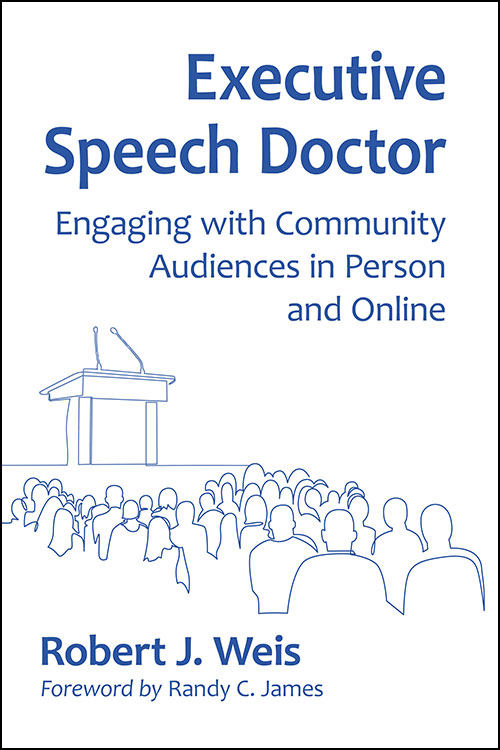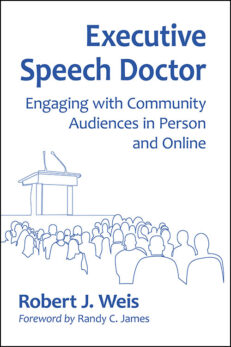Executive Speech Doctor
Engaging with Community Audiences in Person and Online
$29.95
In stock
About the Book
Engaging with the community and responding to the needs of the audience are key elements of being an effective executive speaker. This book addresses the videoconference and in-person public speech needs and interests of CEOs, executive directors, owners, presidents, general managers and other leaders reaching out to community audiences at the local, regional or national levels.
The author presents a new communication model based on decades of scientific co-orientation and community ties research. It includes a fresh perspective on “co-questioning and questioning tactics,” and introduces the new concept of “empathetic outreach.” With 45 chapters of useful tips and advice, this book utilizes anecdotes, examples, testimonials and expert interviews to help guide speakers through various aspects of executive public-speaking.
About the Author(s)
Bibliographic Details
Robert J. Weis
Foreword by Randy C. James
Format: softcover (6 x 9)
Pages: 228
Bibliographic Info: appendices, notes, bibliography, index
Copyright Date: 2023
pISBN: 978-1-4766-9166-4
eISBN: 978-1-4766-4896-5
Imprint: McFarland
Table of Contents
Acknowledgments xi
Foreword by Randy C. James 1
Preface 3
Fundamentals
Chapter 1. Co-Questioning and Empathetic Outreach 7
Chapter 2. Virtual vs. In-Person Public Speaking 11
Chapter 3. Proficient Virtual Delivery 14
Chapter 4. On Getting Invited to Speak 21
Chapter 5. Structure You Can Rely On 26
Chapter 6. Launch Your Creativity with Good Research 29
Chapter 7. Their Thoughts and Your Thoughts 32
Chapter 8. Secret Sauce: Questioning Tactics 37
Chapter 9. Spice in the Sauce: Empathetic Outreach 45
Chapter 10. Put It All Together: A New, Dynamic Model for Executive Public Speaking 53
Chapter 11. Interview to Gather Particulars 54
Chapter 12. Write Inside Out 57
Chapter 13. Put a Face on It, Tell a Story 63
Fine Points
Chapter 14. Virtual Speaking to Major Community Audiences 71
Chapter 15. Virtual Speaking to Smaller, More Interactive Audiences 74
Chapter 16. Create Smooth Transitions 78
Chapter 17. Sharpen Your Writing 82
Chapter 18. A “Show” Within a Show 86
Chapter 19. Be Flexible 91
Chapter 20. In Good Humor—Further Examples 93
Chapter 21. Be True to Your “Voice” 95
Chapter 22. The End (of Your Speech) 98
Chapter 23. Wisdom of the Ages 100
Chapter 24. Anatomy of a Speech 105
Speech Delivery
Chapter 25. Be Well Introduced 113
Chapter 26. Co-Focus Your Opening 115
Chapter 27. Techniques for Good In-Person Delivery 116
Chapter 28. Eliminate Ums, Uhs, and Ahs 119
Chapter 29. Personalize Your Delivery 122
Chapter 30. Q&A Dynamics 125
Chapter 31. The Unfriendly, Perhaps Hostile Audience 128
Chapter 32. Get Useful Audience Feedback 132
Outreach
Chapter 33. Community Outreach as Strategy 137
Chapter 34. Unique “Leaderly” Opportunities 141
Chapter 35. What Program Chairs Look For 145
Chapter 36. A “Rollout” 148
Special Events
Chapter 37. Interviews: What Conference Organizers Look For 155
Chapter 38. Serving on a Panel 159
Chapter 39. Another Perspective on Panels 162
Chapter 40. The Commencement Address 165
Chapter 41. More Ceremonials 169
Further Considerations
Chapter 42. Again, Why Give Speeches to Public Audiences? 173
Chapter 43. Common Mistakes in Giving a Public Speech 177
Chapter 44. Ten “Quick Tips” to Keep in Mind 182
Chapter 45. Use a Speechwriter? 193
Appendix 1: A Sample (Redacted) Executive Community Speech Calendar 197
Appendix 2: Questioning Tactics for Executive Speech Development 199
Appendix 3: How to Co-Question with a Conference Chair 202
Chapter Notes 205
Bibliography 209
Index 215
Book Reviews & Awards
• Winner, 2024 American Library Association Outstanding Reference Source
• “A must-read for those that want to improve their communication skills. Very insightful!”—Luke S. Helms, vice chairman ret., Bank of America
• “This is a very worthy book that has solid theoretical grounding, which leads to a fresh and productive approach to speech writing that will produce long-needed improvements in business communication.”— Keith R. Stamm, professor emeritus, University of Washington
• “Dr. Bob’s co-questioning approach makes perfect sense, a great strategy for getting your speech right from the get-go. Real-world advice, a roadmap for success that begins and ends with engaging one’s audience. A tremendous book.”—Arthur P. Merrick, senior vice president ret., Hill+Knowlton Strategies
• “With Dr. Weis’ help we implemented his principles in my in-person speaking engagements, to great effect. Whether you are looking to improve your delivery or you are new to public speaking, this is hands down the best and most useful resource I have ever read. It will lead you to new levels of excellence in public speaking.”—Kim B. Mackay, president, Lucidoc Corporation, Redmond, Washington
• “I once froze onstage from the sight of what seemed like an overwhelmingly vast audience all staring at me. I had to be helped off stage. Bob’s ‘Co-questioning’ then gave me permission to connect with the audience and develop a feeling of mutuality with a few of them before a speaking engagement, which helped me gain confidence. With the sense of community that flowed from those conversations, my fears dropped away. Thank you, Bob for the gift of co-questioning.”—Ted Leonhardt, former chief creative officer at Fitch Worldwide, London; previously co-founder and creator, The Leonhardt Group, Seattle, Washington
• “Robert Weis brings a wide range of professional experience mixed with keen insight and a healthy dose of practicality to his subject. The book describes a new communications model that is meant to improve business communications. It addresses how to reach an audience by focusing on the fundamentals and adding the fine points, outlining how to develop a speech, understanding the audience for which it was intended, and identifying the key components of speech anatomy, including how to open and end it. In the process, Weis creates a new communications model that he calls empathetic outreach. …a must read for those who speak publicly, assume newly-assume leadership positions, want to improve their skills, or better understand the unspoken and untaught rules of how to speak in public.”—Brian C. Mitchell, former president of Bucknell University and Washington & Jefferson College





